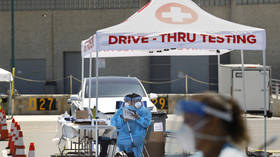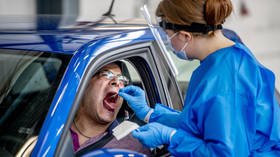Sensitive tests mean that many who test positive for Covid barely carry any virus, making it hard to grasp true reach of disease

It has been revealed that standard tests being used in parts of US to diagnose Covid-19 cases are extremely sensitive, with no guarantee that the vast majority of those marked down as "positive" can spread the disease.
Editor’s note: This article and headline have been amended by the author, as the initial version contained statements that may have been liable to misinterpretation or lacked full context. RT.com supports Covid-19 testing and other widely-adopted public health measures developed to fight the pandemic.
Top US virologists have been stunned by revelations about the laxity of the US Covid testing regimen. It turns out that tests that deliver a simple binary “positive or negative” result are not fit for purpose, as they tell us nothing about the contagiousness of each person.
Data from three US states – New York, Nevada and Massachusetts – shows that when the amount of the virus found in a person is taken into account, up to 90 percent of people who have tested positive could actually have been negative, as they may be carrying only tiny amounts of the virus. If so, these people would likely not be contagious, pose a risk to others, or have any need to isolate – at least at the time of the test.
This raises the distinct possibility that pre-symptomatic, post-symptomatic and asymptomatic cases, could be caught in the net, and without further study it is hard to tell what percentage these constitute of the total.
Also on rt.com White House rejects ‘corrupt’ WHO concerns over Covid-19 vaccine developmentIt’s a sensitive issue
So how could this have happened? The answer has to do with the sensitivity of PCR (Polymerase chain reaction) tests for Covid, which it turns out can be ramped up according to the taste of the testing companies. Most testing companies have chosen the outrageously high sensitivity limit of 40 PCR cycles – meaning that the DNA in a sample is exponentially increased 40 times in order to amplify its signal.
But using such a ridiculously sensitive test means that the faintest traces of a dead virus, or even leftovers from previous infections, can result in a positive. Professor Juliet Morrison, a University of California virologist, said that even a limit of 35 PCR cycles is too high, let alone 40. She said she was “shocked that people would think that 40 could represent a positive.” But apparently, pretty much everyone in the US Covid brain trust took exactly that on faith.
If a significant percentage of tests doesn’t tell us anything about the patient’s true Covid status, the real scale of the pandemic becomes impossible to estimate . For a seasoned ignorer of statistics that contain Covid ‘cases’, there are no surprises here. The truth is, there was never any reason to treat them as written in stone . The FDA, for instance, has only now been forced to concede that they have no idea how different testing companies determine which the positive and negative tests are: they just accept whatever data they are given.
But it should not have taken some journalist to ask the right question to discover this: a bit of common sense would have been enough. What is it going to take for these professional virologists to drop their assumptions and models, and just start acting based on the facts at hand?
Also on rt.com We might have to wait forever for science to show the Covid threat is over, so let’s use our common sense & get back to normalNot fit for purpose?
It would be difficult to argue that the US Covid testing is fit for purpose in its current state. The experts seem to base every decision now on case numbers or derivatives thereof, despite the apparent lack of association between fluctuating case numbers and hospital admissions and deaths; the latter two of which have been relatively negligible for months – even when taking into account recent rises in parts of the world - compared to the springtime peaks. But they keep ringing that bell: ever more testing, they toot, will somehow lead us into their ‘new normal’.
It’s a virus so deadly, you need a test to tell whether you have it or not. So goes the refrain of many lockdown skeptics, Covidiots and anti-maskers, of whom I am an indignant supporter. Something has gone… not just wrong, but totally haywire... when the might of the world’s scientific establishment is trained with the zeal of a Witchfinder General on one particular microscopic particle. Not even one that's most likely to kill you; the latest data show it is the eighth most common cause of death in England, and it doesn’t make the top ten in Wales.
Meanwhile, in Wuhan, the original source of this disease, the pool parties are in full swing. They don’t seem to be too worried about PCR tests or contact tracing, or even the virus itself. The Chinese government says that their supreme lockdown was so awesome that they now have zero Covid: probably a biological impossibility. Maybe they just stopped testing, and decided to get on with their lives. A turn of events we are unlikely to see if the US or Europe any time soon, for better or worse.
Think your friends would be interested? Share this story!
The statements, views and opinions expressed in this column are solely those of the author and do not necessarily represent those of RT.















